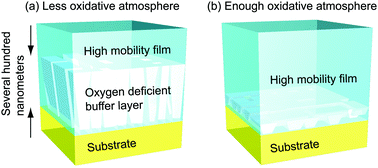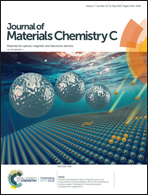Buffer layer-less fabrication of a high-mobility transparent oxide semiconductor, La-doped BaSnO3†
Abstract
La-Doped BaSnO3 (LBSO) is one of the most promising transparent oxide semiconductors because its single crystal exhibits high electron mobility; therefore, it has drawn significant attention in recent years. However, in the LBSO films, it is very hard to obtain high mobility due to threading dislocations, which are caused by the lattice mismatch between the film and the substrate. While previous studies have reported that insertion of buffer layers increases the electron mobilities; this approach leaves much to be desired since it involves a two-step film fabrication process, and the enhanced mobility values are still significantly lower than the single crystal values. Thus, herein, we show that the electron mobility of the LBSO films can be improved without the insertion of any buffer layers if the films are grown under highly oxidative ozone (O3) atmospheres. The O3 environment relaxes the LBSO lattice and reduces the formation of the Sn2+ states, which are known to suppress the electron mobility in LBSO. The resultant O3-LBSO films show improved mobility values up to 115 cm2 V−1 s−1, which are among the highest values reported for the LBSO films on SrTiO3 substrates and comparable to those of the LBSO films with buffer layers.



 Please wait while we load your content...
Please wait while we load your content...